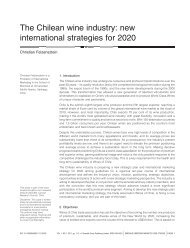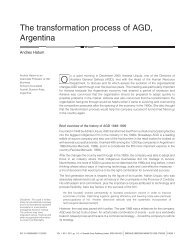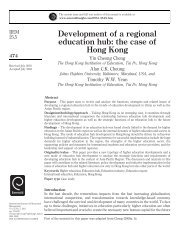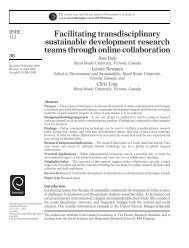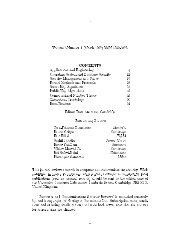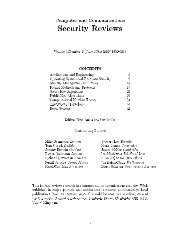CONTENTS - Emerald
CONTENTS - Emerald
CONTENTS - Emerald
Create successful ePaper yourself
Turn your PDF publications into a flip-book with our unique Google optimized e-Paper software.
lock chaining in such a way that protocol element boundaries coincide with cipher<br />
block boundaries.<br />
041424 `A Calculus for Secure Channel Establishment in Open Networks'<br />
UM Maurer, PE Schmid, ESORICS 94 pp 175{192<br />
The authors introduce a new notation to help visualise the security relationships<br />
in a network: A ! B means that A can send a secret message to B, while A ! B<br />
means that A can send an authentic message to B. They develop a set of formal rules<br />
and show that, under reasonable assumptions, ! is equivalent to . Thus one can<br />
see at a glance whether it is possible to set up a con dential or authenticated channel<br />
between two nodes in a network, by looking for a path between them in which the<br />
bullets are all at the same end.<br />
041425 `Formal Veri cation of Cryptographic Protocols: A Survey'<br />
CA Meadows, Asiacrypt 94 pp 117{130<br />
The author gives an overview of the formal techniques used to analyse crypto<br />
protocols. She covers state machine methods, such as Millen's Interrogator and the<br />
NRL Protocol Analyser, both based on the Dolev-Yao model; modal logics such as<br />
BAN; and algebraic approaches such as those of Merritt and Toussaint. She discusses<br />
the problems of protocol idealisation and of model granularity, and considers how formal<br />
methods can be used in the design phase to clarify requirements.<br />
041426 `Application Access Control at Network Level'<br />
R Molva,ERutschke, Fairfax 94 pp 219{228<br />
The authors discuss a mechanism whereby applications use a secure protocol stack<br />
to insert precomputed tickets into packets, and any packets without them are killed at<br />
a rewall. This enables network layer enforcement of application level security policies.<br />
An implementation in IP is described; it is suggested that mechanisms of this kind are<br />
ideal for securing multicast channels, especially against ooding attacks.<br />
041427 `Prerequisite Con dentiality'<br />
JP Nestor, ES Lee, Fairfax 94 pp 282{293<br />
The authors propose a new de nition of con dentiality inmultilevel systems, which<br />
is based on formal modelling by event systems and deterministic regular parsable grammars.<br />
The goal is to build a structure in which composability can be dealt with in a<br />
coherent and rigorous manner. Like Lin's behavioural security model, it is based on<br />
input-output causality and requires that high-level input events never be prerequisites<br />
for low-level output events.<br />
041428 `Secure Agreement Protocols: Reliable and Atomic Group Multicast<br />
in Rampart'<br />
MK Reiter, Fairfax 94 pp 68{80<br />
The author presents new protocols which ensure that all honest members of a group<br />
deliver the same messages in the same order, and describes their implementation in a<br />
toolkit for building high-integrity distributed services. They are based on the author's<br />
secure group membership protocol, and the basic building block isecho multicast: a<br />
single member publishes a message | sends it to all group members | gets their answers,<br />
and publishes these too. It thus gets round the traditional problem of telling<br />
whether a group member is dishonest or merely unreachable, and therefore makes secure<br />
multicast protocols feasible in loosely-coupled asynchronous systems. Performance<br />
measurements for a trial implementation are given.<br />
041429 `A Consideration of the Modes of Operation for Secure Systems'<br />
CL Robinson, SR Wiseman, ESORICS 94 pp 335{356<br />
The authors examine the UK's modes of system operation (dedicated, system high,<br />
compartmented and multilevel) and present of formal model in Z of the underlying<br />
rules. This was of bene t because it forced the authors to examine the di cult aspects<br />
29





